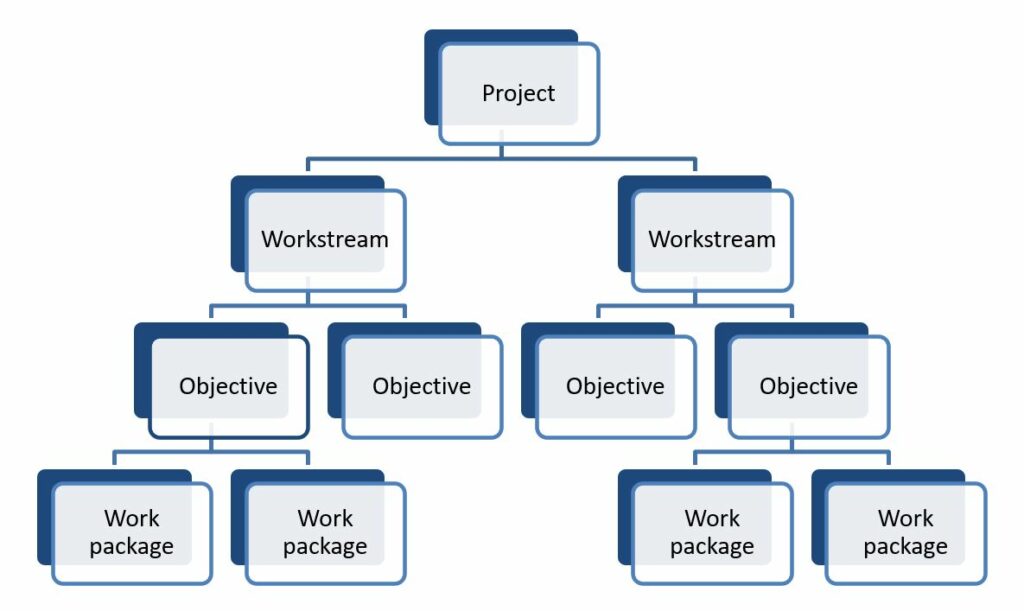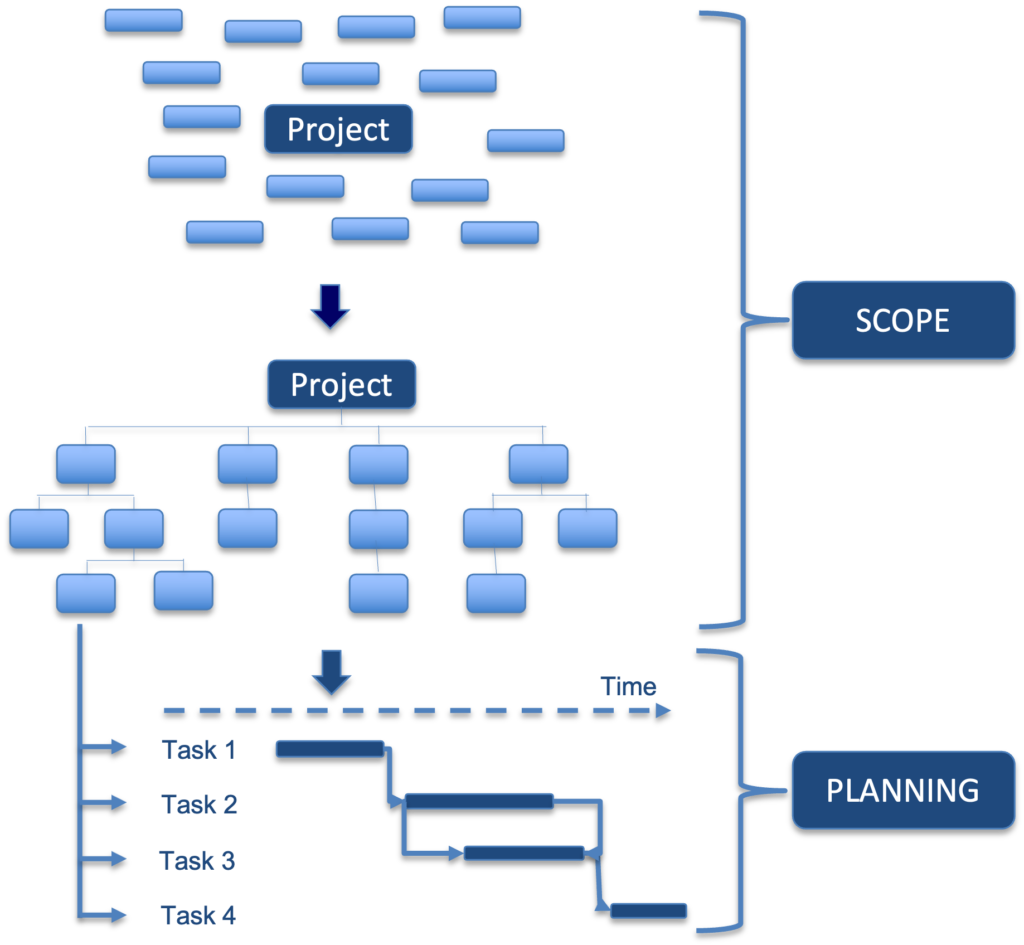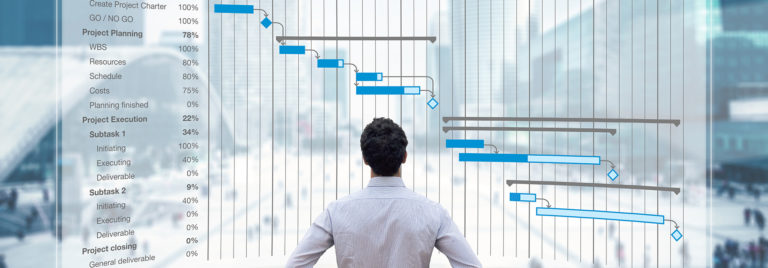Planning in project management is essential to ensure that a project runs smoothly. It is an essential stage in structuring and organising all the actions to be taken in order to achieve the objectives set. It must take into account the expectations and needs of stakeholders, and respond to the three constraints of the Golden Triangle of project management: cost, time and scope. However, it cannot take place without the project initiation which will have previously defined a framework and the project as a whole.

Once this first step has been established, the planning can begin. During the planning stage, the project manager will need to define the key stages and the resources required. The main objective is to keep the project on time and on budget.
To keep project planning as structured as possible, it is recommended to proceed stage by stage:
Effective planning begins with a clear understanding of the scope. This is done by breaking down the scope into elements that enable the project objectives to be achieved via the Work Breakdown Structure (WBS) / Project Task Organisation (PTO) / Project Breakdown Structure (PBS). This stage will involve the project team to ensure a global view of project scope.
After this crucial stage, the project planning stages can follow:
Stage 1: Definition of the different phases of the project
Project management is a process that requires a well-defined structure to ensure consistency and control at every stage. This is why the planning process must start by defining the different phases of the project. These phases may vary depending on the methodology used, whether agile or traditional, but they must all be clearly identified and defined. Generally speaking, each stage of the project should describe the various tasks or activities to be carried out.
Stage 2: Identification of deliverables / activities
Once the stages and tasks have been clearly defined, the project milestones need to be defined. Milestones are the key events in the project, which generally take the form of deliverables. These deliverables are defined with the stakeholders. These are the tangible results that must be produced at each stage and at the end of the project. These deliverables are used to assess the progress of the project and ensure that all tasks are completed on time. It is therefore essential that the deliverables are clearly defined in advance with the whole project team.
Stage 3: Definition of sequences
This third stage involves defining the sequences of tasks to be carried out, which will then determine the total duration of the project. The PERT diagram can be a very good tool to use here, as it identifies tasks in the form of a network and identifies each task, the interdependencies and the execution time required. This diagram provides a real view of the project, and can also be used to create a Gantt chart.
Stage 4: Estimation of the resources required
Project management planning also involves resource management. Resources represent a major item of expenditure in a project, involving both material and human resources, and can be numerous depending on the scale of the project. The aim is to optimise them as far as possible. It is therefore necessary to identify the core skills and resources available for each phase of the project, to ensure that they are allocated effectively.
Stage 5: Estimation of timescales
For a complex project, timescales are estimated using the three-point estimation method. This involves defining three time estimates for each task: a = most optimistic hypothesis, m = most likely hypothesis, b = most pessimistic hypothesis. You can then decide to calculate the weighted average (giving greater weight to the realistic hypothesis) with the formula – E = (a + 4m + b) / 6, or use the triangular distribution (considering each hypothesis equally) with the formula E = (a + m + b) / 3. There are other methods for estimating the timescale of activities, such as estimating in relation to a previous project or by asking experts.

These stages will help define the duration of the project, the critical path(s) and ensure that the deadline objectives are met.
In addition, to do a quality job, it is important to integrate risk management.
It is essential to anticipate potential problems and put in place preventive and corrective measures to minimise their impact on the project. This stage can therefore be described as both proactive and reactive.
This last step will ensure that there is a certain level of slack in the schedule. Schedule risk analysis is applied to simulate the impact of uncertainties and risks on the schedule and thus estimate the probability of achieving the objectives within the predefined times.
Project planning tools
Various tools can be used to achieve clear, coherent project planning. Project management software such as Microsoft Project (MS Project) or Primavera P6 are very useful for facilitating task planning and management. This software allows the deployment of useful project planning tools such as the critical path and the Gantt chart.
The critical path method
In project planning, drawing up a critical path map (CPM) provides a realistic overview of the project. The critical path identifies all the tasks with a direct impact on the project end date, and enables the total duration of the project to be estimated. The particularity of the critical path is that all the tasks are closely linked. If the execution of one task is delayed, then the whole project will be delayed.
The Gantt chart
Planning tools also allow the creation of a Gantt chart that graphically represents the different tasks and milestones in the project, their duration and dependencies. Each task takes the form of a horizontal bar indicating its start and end. The Gantt chart makes it easy to visualise:
- The various activities to be taken into account
- The start and end of each activity
- The expected timeframe for each activity
The possible overlap of activities, and the duration of this overlap - The beginning and end of the project
Depending on the project, one or other of these methods may be chosen, or both.
Project monitoring
Once the plan has been drawn up, it is important to monitor the progress of the project on a regular basis. This ensures that deadlines are met and that tasks are completed on time. In the event of delays, the use of a dynamic planning tool enables the impact of deadlines to be seen, and for them to be highlighted by comparing them with the reference schedule. This makes it possible to work on a response plan to limit the impact on deadlines. Project monitoring can be carried out using management tools such as dashboards, which provide an overall view of the project’s progress. These dashboards can also be accessed using project management software.
Project planning with PROPRISM
Project planning is therefore a crucial stage in ensuring the smooth running and success of a project. It enables all the actions that will be undertaken to be structured and organised, the deliverables to be defined, the resources and risks to be managed, and the progress of the project to be monitored regularly. With rigorous planning, it is possible to optimise project progress, meet deadlines and achieve objectives.
However, companies and organisations do not always have the time or skills needed to carry out effective project planning. PROPRISM thus offers support to companies in the planning of their project, to ensure excellent control of the constraints to be met (deadlines, costs and scope) as well as better monitoring throughout the process.




